
Aromatik Bileşiklerin Palladyum Katalizli Direkt Arilasyonuna Genel Bir Bakış
Şu kitabın bölümü:
Akpınar,
A.
(ed.)
2024.
Fen Bilimleri ve Matematik Üzerine Araştırmalar.
Özet
Aromatik bileşikler biyolojik olarak aktif maddelerin, fonksiyonel materyallerin ve malzeme biliminde kullanılan ticari öneme sahip kimyasalların yapı taşını oluşturan önemli bileşiklerdir. Aromatik bileşiklerin endüstriyel önemi nedeniyle, bu tür bileşiklerin sentezi ve fonksiyonalizasyonu sentetik kimya açısından önemli bir araştırma konusudur. Geçiş metal katalizli C-C çapraz eşleşme tepkimeleri endüstriyel öneme sahip çoğu aromatik bileşiğin sentezinde etkili ve pratik bir yöntem sunmaktadır. Geçtiğimiz 40 yıl boyunca aromatik bileşiklerin sentezinde geçiş metal katalizli C-C çapraz eşleşme tepkimeleri yoğun bir şekilde kullanılmış ve bu tepkimeler günümüzde modern kimyanın en önemli sentetik uygulamalarından biri haline gelmiştir. Bununla birlikte, son zamanlarda aromatik bileşiklerin C(sp2)-H bağı aktivasyonu ile direkt arilasyonu, klasik geçiş metal katalizli C-C çapraz eşleşme tepkimelerine kıyasla daha çevreci ve ekonomik olarak daha çekici bir yöntem sunmaktadır. Bu nedenle, direkt arilasyon yöntemi aromatik bileşiklerin arillenmesinde klasik geçiş-metal katalizli C-C çapraz eşleşme tepkimelerine önemli bir alternatif sunmaktadır.
Bu bölümde, aromatik bileşiklerin C(sp2)-H bağı aktivasyonu ile palladyum katalizli direkt arilasyonu ve bu alanda yaşanan son gelişmeler genel bir bakış açısıyla özetlenmeye çalışılmıştır.

